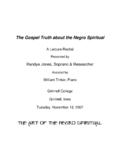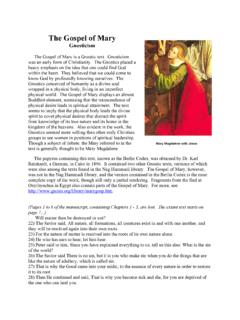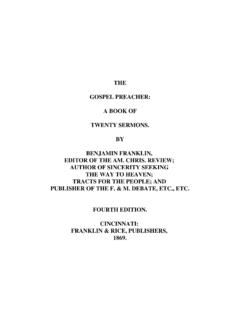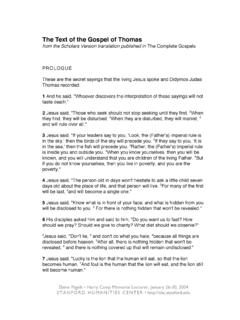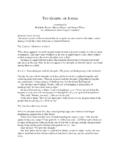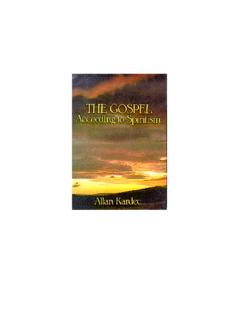Transcription of Gospel of John - White Fields Foundation
1 Gospel of john -Overview & Major Themes The Gospel of john is called the supplemental Gospel because it contains 92% unique material, found nowhere else in the scriptures. The authorship is unanimously attributed to the apostle john (Irenaeus, St. Clement, Eusebius) who is referred to as the disciple whom Jesus loved (13:23, 21:20). There is no mention of him by name in the Gospel which would be a glaring omission (As a strong leader of the early church) if he did not write it. john s Gospel was written to a Greek audience, not unlike our own culture at present in many ways, to show them that Jesus was the eternal Son of God. The developed theology and vast amount of unique material are attributed by some to necessitate dating its authorship in the 90 s or even early 2nd century.
2 Recent scholarship makes a strong case for dating it in the 50 s not conceding to the theological development argument since Paul wrote Romans in that time frame and it too contains a highly developed theology. john used a philosophical term to explain Jesus, calling him the Logos. This was an appeal to the Greek philosophical interest in the Logos as an impersonal yet divine presence that organized the universe. Jesus is the Word expressing the fullness of God. He is the organizing principle of the universe, yet he is in eternity past with the Father and there speaking all of the universe into creation by his powerful word ( john 1:1-3).
3 The Logos became flesh, entered into our humanity in all its fullness and limitations (Yet without sin). john shows us this Jesus as an intimate friend and follower. john was a Jewish believer, deeply schooled in Judaism and the Old testament scripture so he richly presents Jesus as the Messiah to a Jewish audience as well as a Greek audience. He shows that Jesus is greater than the patriarchs Abraham (8:58, Exodus 3:13-14), Jacob (1:50-51, 4:11-14 ), and Moses (1:17-18, 3:14-15). john places his lens on a selective group (20:30b) of miraculous signs culminating in the cross and resurrection. As an eye-witness to it all, he lays out for us the case for believing on Jesus, the Christ of God.
4 john is an evangelist and his primary purpose is to lead us to Jesus, the Lamb of God who takes away the sin of the world. (1:29) Through this belief john promises that we would, like the Greeks of the first and second century, have eternal life in his name (Jn. 20:30-31). Among john s prominent themes is his emphasis on eternal life, Zoe, not Bios, in the Greek. Bios is what we all see and experience in the natural creation. Zoe is a focus on the present dimension of eternal life for the one who is born again (3:3) from above. This life is a result of our oneness with Christ in the Father (17:20-23).The quality and power of this life (10:10, 20:31) will transform us.
5 We will attempt to navigate our way through john s Gospel in 20 weeks, ending sometime in early February. There are many helpful landmarks given if we are careful to pay attention to them. They are the signs (2:11) revealing the glory of God to us. I will blend an exegetical approach in looking at the text (Greek text on occasion, always context, OT background) with a topical approach since john expands upon major themes by spotlighting Jesus teaching and his actions throughout. One example of this is the supremacy of Jesus being the incarnation of grace and truth over Moses, the giver of the Law (v. 1:14). This is prominent in the prologue (1:1-18).
6 john demonstrates this truth in showing us Jesus dialogue with the Pharisees who were desiring to stone a woman who had been caught in adultery (8:1-11). Their justification to stone the woman was found in the Law but Jesus asked simply, He who is without sin among you, let him be the first to throw a stone at her. (8:7) Stooping down he wrote on the ground. Could this be a revelation, a picture of God writing a new commandment? Could this be the very finger of God as it was with the stone tablets given to Moses on Mt. Sinai? Then the one who was without sin said to her, Woman, where are they? Did no one condemn you? She said, No one Lord.
7 And Jesus said, Neither do I condemn you; go your way. From now on sin no more. (8:10-11) Later in the same chapter (8:58) he reveals that he is greater than Abraham and Moses, being the great I AM who spoke to Moses in the burning bush (Exodus 3:14). For this the Pharisees sought to stone him immediately, interpreting by this assertion that he was claiming to be equal with the Father. Here are 7 Themes Developed Extensively in john s Gospel : 1. Jesus reveals the Father God to us. Jesus reveals the father in all his fullness (1:18). He has come from the Father being the Logos of God (1:1-2); He was with him creating the heavens and the earth by his powerful word (1:3).
8 By knowledge of the Father and the Son we obtain eternal life (3:35-36, 17:1-3). Approximately 18 times john uses quotations that refer directly to Jesus relationship with the Father, 3 times more than the 2nd author in this regard. Here are a few: (4:34, 5:20, 10:17,30,38, 13:1, 14:6,9,28, 20:17). 2. Jesus miraculous signs reveal the glory of God. john uses selected signs to reveal the majesty, the otherness of Jesus, the Christ of God. God s greatest sign is the Cross and Resurrection of Christ. Here are some to review: (2:11, 18-19, 4:54, 6:14-15, 9:16, 11:47, 12:23-25, 13:12-17, 19:1-37, 20:26-29). 3. john s primary purpose in the Gospel is to create faith.
9 Jesus life, death, and resurrection are recorded and interpreted by john as an eye-witness so that we might believe Jesus is the Messiah of God. See 1:11-13, 20:30-31, 2:11, 11:25-26. 4. Jesus is eternal, the life he gives to us is eternal life (Zoe); it transcends anything we have ever known in this present life (Bios). This present dimension of eternal life changes us and our world. See 3:16,36, 4:13-14, 17:1-3, 11:25, 14:6. 5. Jesus is the great I AM. john uses 7 self-disclosures of Jesus using Ego Eime in the Greek. These sayings emphasize that He is the eternal God, equal with the Father and revealed to Abraham, Isaac, and Jacob then to Moses in the burning bush (Exodus 3:14).
10 He exists beyond time and space but he enters into our history as the Bread of Life (6:35), the Light of the World (8:12), the Good Shepherd (10:11), the Resurrection and the Life (11:25), the Way, the Truth, and the Life (14:6), and the True Vine (15:1,5). 6. God is one, existing in three divine persons: Father, Son, and Holy Spirit. Jesus reveals both his equality with the Father (See #1) and the person/work of the Holy Spirit, the third member of the Trinity. See (1:32-34, 3:34, 14:15-30, 15:26 to 16:15). 7. Upper Room Dialogue with the Disciples. ( john chapters 13-17) This is the intimate account of Jesus interaction with his disciples before he would be betrayed and abandoned by them.
